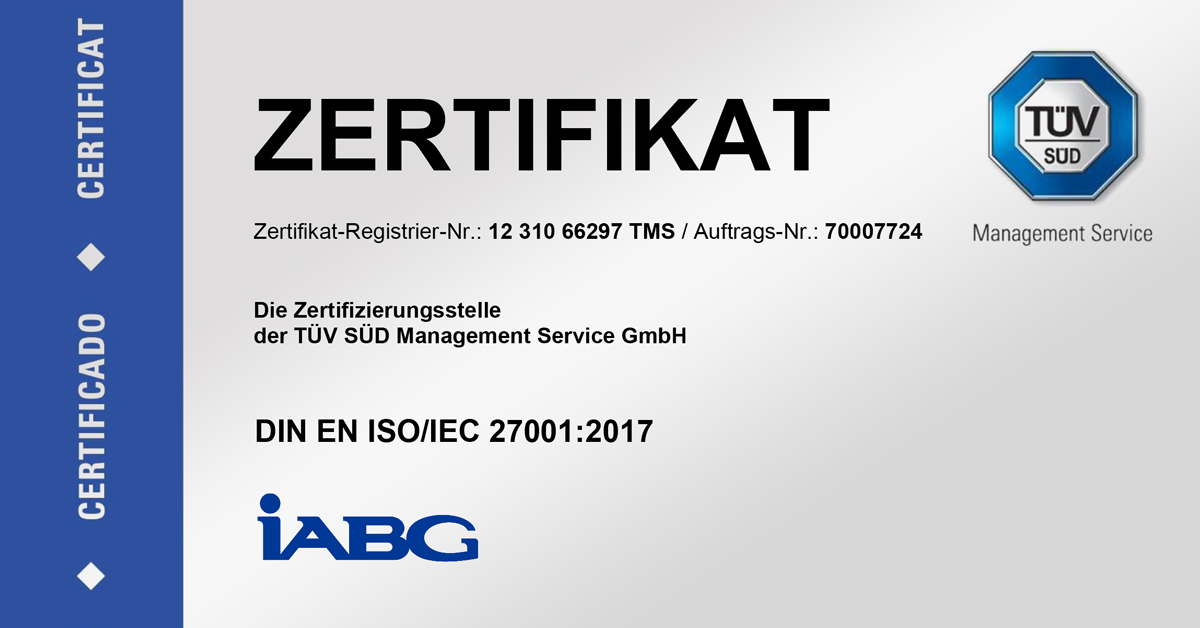The event got off to a flying start, the first visitors waiting punctually at the gates of the newly constructed Technology Centre ahead of the official opening time of 10 am. With its sunlit, canopied atrium, the new building, completed just last year, elicited appreciative nods from incoming guests.
Shortly afterwards, the first group, all kitted out with headsets, made their way to the Space Centre. Christian Henjes, responsible for space-related sales and marketing at the IABG, began by explaining precisely why satellites have to be “qualified” prior to take-off. Were they unable to withstand the extreme loads within the rockets and naturally in outer space itself, thus failing in their task, an extremely large amount of money and effort would be irretrievably lost. Mr Henjes' use of the term "loads" became abundantly clear during the course of the tour of the Space Centre which followed.
We came face to face with a real DUT, or device under test, in the acoustics laboratory, namely the solar panel belonging to the satellite Meteosat. Mr Henjes explained that the acoustic tests only last approximately one minute, and that a launching rocket is capable of travelling so far from earth in this time that the sound waves are no longer reflected. The sound pressure level at the launch is up to 145 dB. The IABG’s test facilities are equipped to withstand 156 dB, and the frequency range can be adjusted to between 30 and 10,000 Hz via modulators. During tests, the noise range is measured using microphones, the so-called “structure responses” of a DUT, including accelerators, resistance strain gauges or load cells. The solar panel passes the acoustic test if it fails to suffer any damage as a result of the noise load.
The next stage involves determining the dynamic characteristics, such as a DUT’s resonance properties, within the context of modal tests. Modal analysis provides an experimental basis, facilitating a verification of mathematical models by means of real structures. It is thus possible to ascertain the degree of insecurity within a particular model.
Mechanical loads, similar to those present at a rocket launch, are simulated during the vibration tests. These tests establish whether vibrations and shocks cause a DUT to suffer mechanical damage or malfunctions, particularly in terms of its resonances. Mr Henjes explained that, as vibrations do not only occur during rocket launches, but also during the transportation of all types of material, it is possible to apply these tests within other fields, too. This is why the space components sitting on the seven “shakers”, each equipped with individual bases and completely separated from the building itself, are frequently joined by other devices.
After a tour of the laboratory where tests to determine electro-magnetic compatibility and bulk characteristics are carried out, the visitors gained an insight into space simulation, during which the extreme temperatures to which a satellite is exposed, namely extreme heat on the side exposed to the sun and extreme cold on the other side, are simulated.
After 45 minutes of concentrated space-related information, the majority of visitors chose to take a small break, enjoy a snack and prepare themselves for round two - an introduction to the aeronautics industry. The IABG has been carrying out structural tests on entire aeroplanes or aircraft components for many years now. Carsten Peters, an IABG test engineer, explained that "we carry out operational stability tests to establish whether aircraft are truly able to withstand the loads to which they are exposed during the course of their service life for the airlines. As far as damage characteristics go, we are therefore facing the future head-on. Our structural tests are an indispensable part of aircraft development and accreditation, in order to guarantee secure operations during subsequent flight use.”
One of the largest service life tests is taking place at the IABG plant in Dresden at the moment. There, what is currently the world’s largest commercial aircraft, the double-decker Airbus A380, is being put through its paces. Preparations for the tests on the military transport aircraft A400M are already underway, with a new test hangar being constructed for this purpose. The IABG has also been selected to carry out two major fatigue tests on the service life expansion of the Airbus A320 in Ottobrunn. The test organisation procedures are due to commence at the beginning of next year.
The way back to the now bustling atrium led us past the IABG teleport, a technical facility affiliated to the infocom department. Joachim von Stieglitz explained that “we cluster over 500 Mbps of data and send them all over the world on behalf of our customers via satellite, using parabola antennas measuring up to 9 m – exactly the same principle as digital TV, but with data instead of pictures. This is useful for companies with field offices in places which lack the necessary communications infrastructure. It goes without saying that we set great store by high data security. The synergies of professional IT service providers who are also well-versed in topics like IT security or complex IP router protocols play an important role here.”
The defence-related demonstrations, included in the programme for the first time this year, were new to all visitors. Manfred Seeger explained the special features of the Simulation, Integration and Test Centre (SIT), one of the outstanding facilities in the new IABG Technology Centre. Here, employees can practise flight assignments using computer-assisted multi-screen split technology. As Mr Seeger explained, "the increasing availability of computing power, coupled with a high degree of networking, is now opening up diverse virtualisation options and allows us to run through a multitude of complex scenarios in a reasonable period of time”. While the focus used to be placed firmly on the simulation of individual systems, it is now possible to reproduce more complex systems with a larger number of participants thanks to today's modern tools. And new methods and tools are precisely what is needed in order to successfully master the demanding tasks which dominate international crisis management – especially in the field of training and practice, and also to support exercises or investigate strategies and weapons systems. Modelling and simulation, a core IABG competency, has always made an invaluable contribution to all these areas.
As expected, the flight simulator was met with boundless enthusiasm by all who inspected it. The privileged winners of the top prize in the raffle were even allowed to take a seat in the cockpit themselves and experience a (simulated) flight in a fighter plane. “You almost feel like Tom Cruise in Top Gun", said one of the lucky winners, eyes agleam.
The aim of the national "German Aerospace Day 2007", held on 16.09.2007 and initiated by the German Aerospace Center (DGLR), was to turn aerospace into a concrete experience and make it more accessible to the public. The patron of the event is Michael Glos, Federal Minister of Economics and Technology.
- Business Fields
-
Automotive
- Automotive
-
-
Testing and fatigue strength
- Testing and fatigue strength
- Complete vehicles
- Vehicle bodies
- Chassis
- Engine & Powertrain
- Interiors
- Safeguarding mechatronic systems
- Advice on Test Programmes and Test Signals
- Prüfstandsbau
- Development Services
- Climatic Environmental Simulation
- Materials Testing and Failure Analysis
- Publications
-
Testing and fatigue strength
-
InfoCom
- InfoCom
-
- Shaping digitization securely
-
Cyber security
- Cyber security
- ISMS and risk analysis
- Technical IT security
- Cyber Defence
- BOS Digital Radio Network
- Industry 4.0 / Internet of Things
- Control and situation centres
- Satellite navigation - Satellite communication
- Safe City
- IT Public procurement management
- Government Agency Networks
-
Mobility • Energy
- Mobility • Energy
-
- Rail & track
- Sicheres Autonomes Fahren
- Testing and qualifying hydrogen technologies
- Construction of burst chambers
- Nuclear technology
-
Safeguarding of artificial intelligence (AI)
- Safeguarding of artificial intelligence (AI)
- The new DIN SPEC 92005
-
Engineering and Support of wind energy plants
- Engineering and Support of wind energy plants
- Technical computations and system simulation
-
Testing & qualification of wind energy plants
- Testing & qualification of wind energy plants
- Test stand construction and testing
- Testing and Fatigue Strength
- Materials Testing and Failure Analysis
-
Mobility services
- Mobility services
- Inductive energy transmission
- Environment & geodata service
-
Aeronautics
- Aeronautics
-
- Experimental testing
- Development of functional and system test benches
- Structural monitoring, inspection and analysis
- Functional Safety and Operational Safety
-
Provision of the test infrastructure
- Provision of the test infrastructure
- Our test halls and test sites
- Functional test benches
- References
- Publications
-
Space
- Space
-
- Mechanical Tests
- Space Simulation tests
-
Electromagnetic Tests
- Electromagnetic Tests
- Electromagnetic compatibility (EMC)
- Magnetic field measurement / Magnetic field simulation
- Infrastructure
- Engineering support
-
Management consulting
- Management consulting
- Programme Support
- Consulting on the implementation of management systems
- Project references
-
Defence & Security
- Defence & Security
-
- Domains
-
Services & solutions
- Services & solutions
- Capability Management
- Procurement support
- Services, operation & training
- Smart Tools
-
Expertise
- Expertise
- Integrated Logistics
- Life Cycle Cost Management
- IT-Security
- Survivability
- Vulnerability & effect on target
- Human factors & ergonomics
- Safety
- Systemic Analysis
- Security Policy
- Architecture & Process modelling
- Modelling & Simulation
- Intelligence, Surveillance & Reconnaissance (ISR)
- Systemt engineering AIR
- System engineering SPACE
- System engineering MARITIME
- Armament
- Sensor systems
- C4I systems
- Protection, Impact- and High Risk Testing
- Technology Roadmapping
- Innovation


